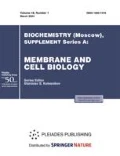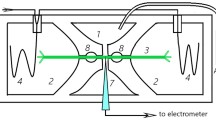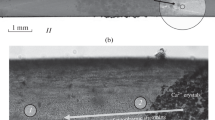Abstract—
Illuminated giant cells of characean algae exhibit membrane excitability as well as the spatial patterns of photosynthesis and transmembrane H+ fluxes. The excitation of plasmalemma under these conditions results in the transient degradation of external alkaline and acid zones and inhibits photosynthesis in the alkaline zones. The generation of action potential in the patterned internodes is followed by cell hyperpolarization that peaks in 1 min and lasts up to 15 min. In order to exclude the influence of drifting resting potential on the chloroplast response to plasma membrane excitation, the voltage clamp mode was applied in this work, and chlorophyll fluorescence changes caused by a short depolarizing pulse were monitored. The depolarizing shift of membrane potential under voltage clamp conditions was found to induce a large depression of \(F_{{\text{m}}}^{{{'}}}\) chlorophyll fluorescence and photosynthetic activity, provided that inward Ca2+ and Cl– currents were triggered and that a steady-state inward H+ flux (or OH– efflux) persisted before the application of an electric stimulus. The depolarization-induced ion currents measured in the alkaline and acidic cell regions under light and in darkness were found to differ significantly. The results are consistent with the notion that the massive inward H+ flow occurring in the alkaline cell regions under illumination is associated with the acidic shift of cytoplasmic pH. Divergent amplitudes of ionic currents in different cell parts can be partially determined by the presence of numerous plasmalemmal invaginations, charasomes specifically localized in the acid zones, as well as by sharp local changes in external pH in acid zones during the perforation of cell wall with a measuring microelectrode.




Similar content being viewed by others
REFERENCES
Bulychev A.A., Vredenberg W.J. 1995. Enhancement of the light-triggered electrical response in plant cells following their de-energization with uncouplers. Physiol. Plant.94, 64–70.
Trebacz K., Sievers A. 1998. Action potentials evoked by light in traps of Dionaea muscipula Ellis. Plant Cell Physiol.39, 369–372.
Bulychev A.A., Kamzolkina N.A. 2006. Effect of action potential on photosynthesis and spatially distributed H+ fluxes in cells and chloroplasts of Chara corallina.Russ. J. Plant Physiol.53, 1–9.
Pavlovic A., Demko V., Hudák J. 2010. Trap closure and prey retention in Venus flytrap (Dionaea muscipula) temporarily reduces photosynthesis and stimulates respiration. Ann. Bot.105, 37–44.
Krupenina N.A., Bulychev A.A. 2007. Action potential in a plant cell lowers the light requirement for non-photochemical energy-dependent quenching of chlorophyll fluorescence. Biochim. Biophys. Acta.1767, 781–788.
Bulychev A.A., Kamzolkina N.A., Rubin A.B. 2005. Effect of plasmalemma electrical excitation on photosystem II activity and nonphotochemical quenching in chloroplasts of cell domains in Chara corallina.Dokl. Biochem. Biophys.401, 127–130.
Bulychev A.A., Kamzolkina N.A. 2006. Differential effects of plasma membrane electric excitation on H+ fluxes and photosynthesis in characean cells. Bioelectrochemistry. 69, 209–215.
Williamson R.E., Ashley C.C. 1982. Free Ca2+ and cytoplasmic streaming in the alga Chara.Nature.296, 647–651.
Berestovsky G.N., Kataev A.A. 2005. Voltage-gated calcium and Ca2+-activated chloride channels and Ca2+ transients: Voltage-clamp studies of perfused and intact cells of Chara.Eur. Biophys. J.34, 973–986.
Stael S., Wurzinger B., Mair A., Mehlmer N., Vothknecht U.C., Teige M. 2012. Plant organellar calcium signalling: An emerging field. J. Exp. Bot.63, 1525–1542.
Hochmal A.K., Schulze S., Trompelt K., Hippler M. 2015. Calcium-dependent regulation of photosynthesis. Biochim. Biophys. Acta.1847, 993–1003.
Bulychev A.A., Kamzolkina N.A., Luengviriya J., Rubin A.B., Müller S.C. 2004. Effect of a single excitation stimulus on photosynthetic activity and light-dependent pH banding in Chara cells. J. Membr. Biol.202, 11–19.
Krupenina N.A., Bulychev A.A., Roelfsema M.R.G., Schreiber U. 2008. Action potential in Chara cells intensifies spatial patterns of photosynthetic electron flow and non-photochemical quenching in parallel with inhibition of pH banding. Photochem. Photobiol. Sci.7, 681–688.
Ruban A.V., Johnson M.P., Duffy C.D.P. 2012. The photoprotective molecular switch in the photosystem II antenna. Biochim. Biophys. Acta.1817, 167–181.
Goh C.H., Schreiber U., Hedrich R. 1999. New approach of monitoring changes in chlorophyll a fluorescence of single guard cells and protoplasts in response to physiological stimuli. Plant, Cell Environ.22, 1057–1070.
Bulychev A.A., Cherkashin A.A., Rubin A.B., Vredenberg W.J., Zykov V.S., Müller S.C. 2001. Comparative study on photosynthetic activity of chloroplasts in acid and alkaline zones of Chara corallina.Bioelectrochemistry. 53, 225–232.
Lunevsky V.Z., Zherelova O.M., Vostrikov I.Y., Berestovsky G.N. 1983. Excitation of Characeae cell membranes as a result of activation of calcium and chloride channels. J. Membr. Biol.72, 43–58.
Kataev A.A. 2008. Functional properties of Ca2+-activated chloride channels in characean algae. Cand. Sci. (Biol.) Diss. Pushchino, Institute of Cell Biophysics, Russ. Acad. Sci., 2008.
Beilby M.J., Al Khazaaly S. 2009. The role of H+/OH– channels in the salt stress response of Chara australis.J. Membr. Biol.230, 21–34.
Bulychev A.A., Krupenina N.A. 2009. Transient removal of alkaline zones after excitation of Chara cells is associated with inactivation of high conductance in the plasmalemma. Plant Signal. Behav.4, 727–734.
Beilby M.J., Bisson M.A. 1992. Chara plasmalemma at high pH: Voltage dependence of the conductance at rest and during excitation. J. Membr. Biol.125, 25–39.
Beilby M.J., Mimura T., Shimmen T. 1993. The proton pump, high pH channels, and excitation: Voltage clamp studies of intact and perfused cells of Nitellopsis obtusa.Protoplasma. 175, 144–152.
Lucas W.J., Nuccitelli R. 1980. \({\text{HCO}}_{3}^{-}\) and OH– transport across the plasmalemma of Chara.Planta. 150, 120–131.
Coster H.G.L. 1966. Chloride in cells of Chara australis.Aust. J. Biol. Sci.19, 545–554.
Johannes E., Crofts A., Sanders D. 1998. Control of Cl– efflux in Chara corallina by cytosolic pH, free Ca2+, and phosphorylation indicates a role of plasma membrane anion channels in cytosolic pH regulation. Plant Physiol.118, 173–181.
Bulychev A.A., Komarova A.V. 2014. Long-distance signal transmission and regulation of photosynthesis in characean cells. Biochemistry (Moscow), 79, 273–281.
Feijó J.A., Sainhas J., Hackett G.R, Kunkel J.G., Hepler P.K. 1999. Growing pollen tubes possess a constitutive alkaline band in the clear zone and a growth-dependent acidic tip. J. Cell Biol.144, 483–496.
Bulychev A.A. Komarova A.V. 2017. Photoregulation of photosystem II activity mediated by cytoplasmic streaming in Chara and its relation to pH bands. Biochim. Biophys. Acta.1858, 386–395.
Bulychev A.A., Krupenina N.A. 2019. Interchloroplast communications in Chara are suppressed under the alkaline bands and are relieved after the plasma membrane excitation. Bioelectrochemistry.129, 62–69.
Behera S., Zhaolong X., Luoni L., Bonza M.C., Doccula F.G., De Michelis M.I., Morris R.J., Schwarzländer M., Costa A. 2018. Cellular Ca2+ signals generate defined pH signatures in plants. Plant Cell.30, 2704–2719.
Plieth C., Sattelmacher B., Hansen U.P. 1997. Cytoplasmic Ca2+–H+ exchange buffers in green algae. Protoplasma. 198, 107–124.
Franceschi V.R., Lucas W.J. 1980. Structure and possible function(s) of charasomes; complex plasmalemma-cell wall elaborations present in some characean species. Protoplasma.104, 253–271.
Schmölzer P.M., Höftberger M., Foissner I. 2011. Plasma membrane domains participate in pH banding of Chara internodal cells. Plant Cell Physiol.52, 1274–1288.
Chilcott T.C., Coster H.G.L. 1999. Electrical impedance tomography study of biological processes in a single cell. Ann. N.Y. Acad. Sci.873, 269–286.
Bulychev A.A., Alova A.V., Bibikova T.N. 2013. Strong alkalinization of Chara cell surface in the area of cell wall incision as an early event in mechanoperception. Biochim. Biophys. Acta.1828, 2359–2369.
ACKNOWLEDGMENTS
The study was supported by the Russian Foundation for Basic Research (project no. 20-54-12 015).
Author information
Authors and Affiliations
Corresponding author
Ethics declarations
The authors declare that they have no conflicts of interest.
This article does not contain any studies with human participants or animals performed by any of the authors.
Additional information
Translated by A. Bulychev
Abbreviations: PM, plasma membrane; PSII, photosystem II; pHc, cytoplasmic pH; pHo, pH on cell surface.
Rights and permissions
About this article
Cite this article
Bulychev, A.A., Krupenina, N.A. & Cherkashin, A.A. Effect of Plasma Membrane Ion Currents on Chlorophyll Fluorescence and Excitation Quenching in Chara Chloroplasts. Biochem. Moscow Suppl. Ser. A 14, 310–318 (2020). https://doi.org/10.1134/S1990747820040042
Received:
Revised:
Accepted:
Published:
Issue Date:
DOI: https://doi.org/10.1134/S1990747820040042




